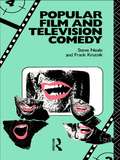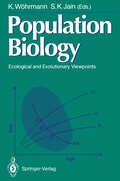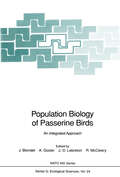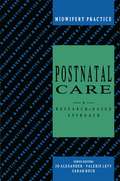- Table View
- List View
Popular Film and Television Comedy
by Frank Krutnik Steve NealeSteve Neale and Frank Krutnik take as their starting point the remarkable diversity of comedy's forms and modes - feature-length narratives, sketches and shorts, sit-com and variety, slapstick and romance. Relating this diversity to the variety of comedy's basic conventions - from happy endings to the presence of gags and the involvement of humour and laughter - they seek both to explain the nature of these forms and conventions and to relate them to their institutional contexts. They propose that all forms and modes of the comic involve deviations from aesthetic and cultural conventions and norms, and, to demonstrate this, they discuss a wide range of programmes and films, from Blackadder to Bringing up Baby, from City Limits to Blind Date, from the Roadrunner cartoons to Bless this House and The Two Ronnies. Comedies looked at in particular detail include: the classic slapstick films of Keaton, Lloyd, and Chaplin; Hollywood's 'screwball' comedies of the 1930s and 1940s; Monty Python, Hancock, and Steptoe and Son. The authors also relate their discussion to radio comedy.
Popular Film and Television Comedy
by Frank Krutnik Steve NealeSteve Neale and Frank Krutnik take as their starting point the remarkable diversity of comedy's forms and modes - feature-length narratives, sketches and shorts, sit-com and variety, slapstick and romance. Relating this diversity to the variety of comedy's basic conventions - from happy endings to the presence of gags and the involvement of humour and laughter - they seek both to explain the nature of these forms and conventions and to relate them to their institutional contexts. They propose that all forms and modes of the comic involve deviations from aesthetic and cultural conventions and norms, and, to demonstrate this, they discuss a wide range of programmes and films, from Blackadder to Bringing up Baby, from City Limits to Blind Date, from the Roadrunner cartoons to Bless this House and The Two Ronnies. Comedies looked at in particular detail include: the classic slapstick films of Keaton, Lloyd, and Chaplin; Hollywood's 'screwball' comedies of the 1930s and 1940s; Monty Python, Hancock, and Steptoe and Son. The authors also relate their discussion to radio comedy.
Population Biology: Ecological and Evolutionary Viewpoints
by K. Wöhrmann S. K. JainFascinated by the diversity of living organisms, humans have always been curious about its origin. Darwin was the first to provide the scholary and persuasive thesis for gradual evolution and speciation under natural selection. Although we now have much information on evolution, we still don't understand it in detail. Many questions still remain open due to the complexity and multiplicity of interacting factors. Several approaches mainly arising from population ecology and genetics are presented in this book in order to help understand genetic variation and evolution.
Population Biology of Passerine Birds: An Integrated Approach (Nato ASI Subseries G: #24)
by Jacques Blondel Andrew Gosler Jean-Dominique Lebreton Robin McCleeryPopulation Biology of Passerine Birds is an up-to-date synthesis of the most recent developments in its field, especially in the framework of modern life history theories. Major topics include quantitative genetics, ecological physiology, the study of social structures using individually marked birds in the wild, and finally biometry, which allows to quantify such important parameters as survival at different stages of life and to create a model of the overall demography of the populations.
Population Dynamics in Variable Environments (Lecture Notes in Biomathematics #85)
by Shripad TuljapurkarDemography relates observable facts about individuals to the dynamics of populations. If the dynamics are linear and do not change over time, the classical theory of Lotka (1907) and Leslie (1945) is the central tool of demography. This book addresses the situation when the assumption of constancy is dropped. In many practical situations, a population will display unpredictable variation over time in its vital rates, which must then be described in statistical terms. Most of this book is concerned with the theory of populations which are subject to random temporal changes in their vital rates, although other kinds of variation (e. g. , cyclical) are also dealt with. The central questions are: how does temporal variation work its way into a population's future, and how does it affect our interpretation of a population's past. The results here are directed at demographers of humans and at popula tion biologists. The uneven mathematical level is dictated by the material, but the book should be accessible to readers interested in population the ory. (Readers looking for background or prerequisites will find much of it in Hal Caswell's Matrix population models: construction, analysis, and in terpretation (Sinauer 1989) ). This book is in essence a progress report and is deliberately brief; I hope that it is not mystifying. I have not attempted to be complete about either the history or the subject, although most sig nificant results and methods are presented.
Possession: A Romance (Everyman's Library Contemporary Classics Ser.)
by A S Byatt'Shimmers with something close to genius... it is a modern masterpiece' Daily MailRediscover the classic Booker Prize-winning novel of romance, history, intrigue, and high drama.Possession is an exhilarating novel of wit and romance, at once a literary detective novel and a triumphant love story. It is the tale of a pair of young scholars investigating the lives of two Victorian poets. Following a trail of letters, journals and poems they uncover a web of passion, deceit and tragedy, and their quest becomes a battle against time.'A novel for every taste... You turn the last age and feel stunned and elated, happy to have the chance to read it' Washington Post'A triumphant success on every level' Cosmopolitan
The Post-Colonial Critic: Interviews, Strategies, Dialogues
by Gayatri Chakravorty Spivak Sarah HarasymGayatri Spivak, one of our best known cultural and literary theorists, addresses a vast range of political questions with both pen and voice in this unique book. The Post-Colonial Critic brings together a selection of interviews and discussions in which she has taken part over the past five years; together they articulate some of the most compelling politico-theoretical issues of the present. In these lively texts, students of Spivak's work will identify her unmistakeable voice as she speaks on questions of representation and self-representation, the politicization of deconstruction; the situations of post-colonial critics; pedagogical responsibility; and political strategies.
The Post-Colonial Critic: Interviews, Strategies, Dialogues
by Gayatri Chakravorty Spivak Sarah HarasymGayatri Spivak, one of our best known cultural and literary theorists, addresses a vast range of political questions with both pen and voice in this unique book. The Post-Colonial Critic brings together a selection of interviews and discussions in which she has taken part over the past five years; together they articulate some of the most compelling politico-theoretical issues of the present. In these lively texts, students of Spivak's work will identify her unmistakeable voice as she speaks on questions of representation and self-representation, the politicization of deconstruction; the situations of post-colonial critics; pedagogical responsibility; and political strategies.
Post-Marxist Alternatives: The Construction of Social Orders
by Nicos P. MouzelisMouzelis puts forward a post-Marxist conceptual framework which overcomes economic reductionism while retaining some distinctive features of the Marxist paradigm which are seen to be indispensable for an examination of how whole social orders are constituted, maintained and transformed.
The Post-Romantics (Routledge Library Editions: Romanticism)
by Donald ThomasThe Post-Romantics, first published in 1990, provides a clear, introductory guide to the literary careers and reputations of five major Victorian poets: Tennyson, Browning, Arnold, Swinburne and Clough. Heirs to the Romantics tradition, the predecessors of the moderns. This accessible and invaluable guide with help readers to develop an informed, individual response to the poetry of the post-romantics.
The Post-Romantics (Routledge Library Editions: Romanticism)
by Donald ThomasThe Post-Romantics, first published in 1990, provides a clear, introductory guide to the literary careers and reputations of five major Victorian poets: Tennyson, Browning, Arnold, Swinburne and Clough. Heirs to the Romantics tradition, the predecessors of the moderns. This accessible and invaluable guide with help readers to develop an informed, individual response to the poetry of the post-romantics.
Post-Transcriptional Control of Gene Expression (Nato ASI Subseries H: #49)
by John E. G. McCarthy Mick F. TuiteThe last ten years have witnessed a remarkable increase in our awareness of the importance of events subsequent to transcriptional initiation in terms of the regulation and control of gene expression. In particular, the development of recombinant DNA techniques that began in the 1970s provided powerful new tools with which to study the molecular basis of control and regulation at all levels. The resulting investigations revealed a diversity of post-transcriptional mechanisms in both prokaryotes and eukaryotes. Scientists working on translation, mRNA stability, transcriptional (anti)termination or other aspects of gene expression will often have met at specialist meetings for their own research area. However, only rarely do workers in different areas of post-transcriptional control/ regulation have the opportunity to meet under one roof. We therefore thought it was time to bring together leading representatives of most of the relevant areas in a small workshop intended to encourage interaction across the usual borders of research, both in terms of the processes studied, and with respect to the evolutionary division prokaryotes/eukaryotes. Given the breadth of topics covered and the restrictions in size imposed by the NATO workshop format, it was an extraordinarily difficult task to choose the participants. However, we regarded this first attempt as an experiment on a small scale, intended to explore the possibilities of a meeting of this kind. Judging by the response of the participants during and after the workshop, the effort had been worthwhile.
Postharvest Biotechnology of Flowers and Ornamental Plants
by Dattajirao K. Salunkhe Narayana R. Bhat Babasaheb B. DesaiThe floricultural industry has been undergoing an unprecedented revolu tion in terms of the type of commodity produced and the production and marketing technology in both developed and developing countries. As a result of this revolution, as we know today, there is a flower for every purpose and for every person in the world, as is evident from the slogan of the Society for American Florists: "say it with flowers". In re cent years, the Latin American and European countries have become sizeable competitors for the North American fresh flower markets and the trend continues growing. Like any other crop production, floricultural production can be divided into three basic factors: (1) production costs (2) quality (3) transportation costs. All these must be optimum for this area or industry to be safe from competition. With increasing consumer awareness and the current recession, the pressure from the artificial floral products in dustry and also of neighbouring countries on the American fresh flower industry, and continued competition even amongst the growers, whole salers and retailers, quality in floricultural industry is becoming increas ingly important to all those concerned with handling these products. The visual quality aspects of the product are the sole determiner of consumer acceptability in this industry and, unlike fruits and vegetables, flowers cannot be marketed by just discarding the damaged portion.
Postmodernism And Society (Communications and Culture)
by Ali Rattansi Roy BoyneNeither a manifesto nor a one-sided critique, this new book introduces a number of original essays exploring various aspects of that contemporary cultural phenomenon named postmodernism. These essays are prefaced by an introductory essay which sets out the major lines of a debate which is about nothing less than the current shape and future prospects of our society.
Postmortem: Ein Kay-scarpetta-roman (Scarpetta #1)
by Patricia CornwellThe first book in the Kay Scarpetta series, from No. 1 bestselling author Patricia Cornwell.'America's most chilling writer of crime fiction' The TimesA serial killer is on the loose in Richmond, Virginia. Three women have died, brutalised and strangled in their own bedroom. There is no pattern: the killer appears to strike at random - but always early on Saturday mornings. So when Dr Kay Scarpetta, chief medical officer, is awakened at 2.33 am, she knows the news is bad: there is a fourth victim. And she fears now for those that will follow unless she can dig up new forensic evidence to aid the police.But not everyone is pleased to see a woman in this powerful job. Someone may even want to ruin her career and reputation ...'The top gun in this field' - Daily Telegraph'Forget the pretenders. Cornwell reigns' - Mirror'The Agatha Christie of the DNA age' - Express
Poultry & Game
by Ian McAndrewPoultry, but more especially game, is a subject close to my heart. Why? Wellfor the last eight years or so I have been, and indeed still am, a keen shooting man. Shooting for sport, I know, is a subject many people find disagreeable, and the an- bloodsports league is a powerful lobby. Nevertheless, it is a pastime that is becoming more and more popular as years go by and one I hope to continue enjoyingfor many years to come. Without it not only would a part of our history and culture be lost, but our wildlife would become threatened, wildlife and habitat conservancy a thing of the past, and the countryside turned into even greater areas of wheat and rape deserts. No one would know the pleasures of the first woodcock or the first English partridge of the season. Imagine a cold winter's morning: a thin covering of snow, the grey skies heavy with more, ready to discharge their cargo without notice. Pick up the gun, call the dogs and set out across the fields. Silence prevails. In the distance, a handful of pigeons are heading this way. Crouching in the hedgerow I wait for them to come within range. Pigeon terrine, pigeon salad with a few toasted kernels, all the menu ideas running through my head, but to no avail, I've been spotted. Truffle and Bella (my dogs) are worrying a patch of brambles, not too keen on going in. Bella scrambles in, belly flat to the ground.
Power, Competition and the State: Volume 2
by K. Middlemas'An extraordinarily rich and suggestive work, full of illuminating asides and thought-provoking insights, backed by a formidable mastery of detail. This is a magnificent achievement.' David Marquand In the forefront of contemporary history, this volume displays the same breadth, originality and innovation as the first. The start of intense rivalry between industry, trade unions and the financial sector, to influence policy in postwar Britain, increased in the late 1950s. Macmillan's government succeeded briefly in restoring some of the original wartime consensus after 1961, only to see hopes for Conservative planning wither. Competition among interest groups to settle how the national interest should be defined made Wilson's attempt to create a Labour planned economy almost impossible. Despite the spur of relative decline, modernisation always fell far short of politicians' aims, putting in doubt the ability of even a modern state to achieve its ambitions. A series of crises exposed promises of breakthrough into growth, which governments blamed on the self-interest of institutions - without whose co-operation they still believed they could not govern.
The Power Elite and the State
by G. William DomhoffThis volume presents a network of social power, indicating that theories inspired by C.Wright Mills are far more accurate views about power in America than those of Mills's opponents.Dr. Domhoff shows how and why coalitions within the power elite have involved themselves in such policy issues as the Social Security Act (1935) and the Employment Act (1946), and how the National Labor Relations Act (1935) could pass against the opposition of every major corporation. The book descri bes how experts worked closely with the power elite in shaping the plansfor a post-World War II world economic order, in good part realized during the past 30 years. Arguments are advanced that the fat cats who support the Democrats cannot be understood in terms of narrow self-interest, and that moderate conservatives dominated policy-making under Reagan.
The Power Elite and the State
by G. William DomhoffThis volume presents a network of social power, indicating that theories inspired by C.Wright Mills are far more accurate views about power in America than those of Mills's opponents.Dr. Domhoff shows how and why coalitions within the power elite have involved themselves in such policy issues as the Social Security Act (1935) and the Employment Act (1946), and how the National Labor Relations Act (1935) could pass against the opposition of every major corporation. The book descri bes how experts worked closely with the power elite in shaping the plansfor a post-World War II world economic order, in good part realized during the past 30 years. Arguments are advanced that the fat cats who support the Democrats cannot be understood in terms of narrow self-interest, and that moderate conservatives dominated policy-making under Reagan.
Power, Protection, and Free Trade: International Sources of U.S. Commercial Strategy, 1887–1939 (Cornell Studies in Political Economy)
by David A. LakeWhy do nations so frequently abandon unrestricted international commerce in favor of trade protectionism? David A. Lake contends that the dominant explanation, interest group theory, does not adequately explain American trade strategy or address the contradictory elements of cooperation and conflict that shape the international economy. Power, Protection, and Free Trade offers an alternative, systemic approach to trade strategy that builds on the interaction between domestic and international factors. In this innovative book, Lake maintains that both protection and free trade are legitimate and effective instruments of national policy, the considered responses of nations to varying international structures.
Poxviruses (Current Topics in Microbiology and Immunology #163)
by Richard W. Moyer Peter C. TurnerThe purpose of this volume is to highlight some current areas of poxvirus research which are likely to be particularly fruitful in the upcoming few years. The first chapter, by Drs. Condit and Niles, discusses poxvirus genetics. Work in this area has provided mutants, produced practical procedures to simplify the manipulation of viral genes, and generated information about the molecular architecture and organization of genes characteristic of pox viruses. One of the most intensively studied regions of the viral genome is the HindIII D region of vaccinia, in which a combination of classical and molecular genetic analysis of the region has been particularly revealing. Within this region are open reading frames, some of which are expressed early and others late, organized in a fashion which is now known to be typical of these viruses. Other studies, related to temperature sensitive, drug resistant, and drug dependent mutants, are also discussed. Each of the other reviews included in this volume summarizes areas of research which have depended heavily on the genetics of the system. The intracellular site of a poxvirus infection is mostly, if not exclusively, limited to the cytoplasm which dictates several interesting biological ramifications. For example, poxvirus transcription must occur in the cytoplasm, rather than in the nucleus. The virus copes with this situation by incorporating into the virion the enzymatic machinery necessary to initiate transcription from input virus.
The Practical Application of Medical and Dental Hypnosis
by Milton H. Erickson Seymour Hershman Irving I. Secter"During the past several years there have been ever-increasing numbers of physicians, dentists, and psychologists interested in hypnosis, both therapeutic and investigative. Reliable sources of clinical information and instruction were practically non-existent except for a few scattered individuals. To meet this need, to interest universities, and to stimulate medical and dental schools to an awareness of the importance of teaching clinical hypnosis, a group of experienced clinicians competent in teaching were formed. Throughout the United States, under the auspices of various professional societies and universities, this group conducted seminars on hypnosis."This book is compiled from the tape recordings of dozens of those seminars, and thus it contains the material as it was presented, with all the simplicity, directness, and effectiveness of the classroom presentation."It is no more, no less, than a comprehensive presentation of the material upon which thousands of clinicians throughout the United States have based the initiation and development of their successful clinical use of hypnosis."-Milton H. Erickson, M.D. (1961)
The Practical Application of Medical and Dental Hypnosis
by Milton H. Erickson Seymour Hershman Irving I. Secter"During the past several years there have been ever-increasing numbers of physicians, dentists, and psychologists interested in hypnosis, both therapeutic and investigative. Reliable sources of clinical information and instruction were practically non-existent except for a few scattered individuals. To meet this need, to interest universities, and to stimulate medical and dental schools to an awareness of the importance of teaching clinical hypnosis, a group of experienced clinicians competent in teaching were formed. Throughout the United States, under the auspices of various professional societies and universities, this group conducted seminars on hypnosis."This book is compiled from the tape recordings of dozens of those seminars, and thus it contains the material as it was presented, with all the simplicity, directness, and effectiveness of the classroom presentation."It is no more, no less, than a comprehensive presentation of the material upon which thousands of clinicians throughout the United States have based the initiation and development of their successful clinical use of hypnosis."-Milton H. Erickson, M.D. (1961)



















